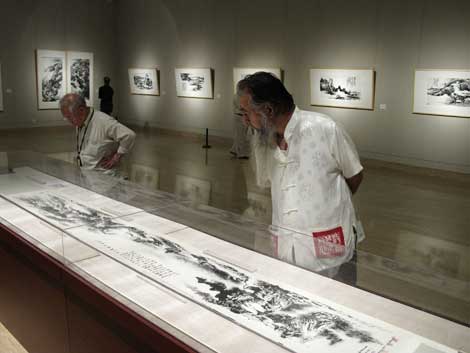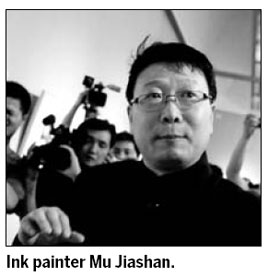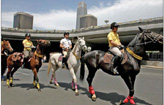Chinese Way
Dry inks filled with feeling
Updated: 2011-06-10 07:56
By Zhu Linyong (China Daily)
|
 At the solo exhibiiton of Mu Jiashan, viewers can enjoy the neo-literati landscape paintings done with the dry brush dipped in thick ink. Jiang Dong / China Daily |
A US-based Chinese artist scales new heights with his landscape paintings. Zhu Linyong reports.
For Mu Jiashan, artistic creation is like an adventure.
"I love holding a soft, untamable Chinese painting brush in my hand, reveling in the feel of xuan (rice paper), and observing the ever-changing shades of ink," Mu writes in the catalog for his solo exhibition Vast Land of Sublimity running at the National Art Museum of China in central Beijing.
A Chinese artist living in the United States, Mu has long been hailed as an innovative painter of the neo-literati painting school.
Borrowing from official-scholar painting traditions, this school of painting that emerged in the 1980s was "a reaction to the sweeping influence of newly imported Western ideas, and a counterbalance to the politically-charged, socialist realism art predominant in the first three decades of New China", according to Xue Yongnian, a veteran art historian with the Central Academy of Fine Arts (CAFA).
The ongoing exhibition displays some 40 visually imposing jiaomo (dry ink) paintings - a result of Mu's latest adventures in this field.
"2011 has definitely been a watershed year in my artistic career", recalls Mu at a recent seminar on his art in Beijing.
"In a short span of a few weeks before, during and after the Spring Festival, I was suddenly inspired to change my style."

A time-honored tradition, Chinese landscape art - that expresses the creator's inner feelings through subjective imageries, rather than realistic depiction of natural scenes - has evolved greatly, notes National Art Museum dean Fan Di'an.
Inheriting traditions while making breakthroughs in personal style has long been a challenge facing generations of Chinese ink artists, Fan says.
"Mu has excelled in forging a broad artistic vision, a refreshingly new outlook, innovative artistic concepts, bold brushwork and newly invented ink techniques," Fan says.
The artist's new style forms a striking contrast with that of many other prominent painters and painting schools in Chinese art history, adds Shang Hui, critic and editor-in-chief of Fine Arts magazine in Beijing.
In Shang's view, Mu's dry ink landscape art goes beyond the approach spearheaded by older generations of artists.
The jiaomo shanhui, or dry ink landscapes - paintings done with the dry brush dipped in thick ink - is an important and traditional art genre in China.
"The art of dry ink landscape always poses a formidable challenge to the artists - reduced water usage impedes brush movement and the free flow of rhythm", says CAFA's Xue.
A well-known dry ink landscape painter of ancient China is Qing Dynasty (1644-1911) scholar Cheng Sui of the Xin'an Painting School, named after the Xin'an River in eastern Anhui province.
However, Cheng's dry ink creations, "typified by the dry, dull autumn winds, depict only the melancholy and nostalgia of cynical descendants and followers of the fallen dynasties of yesteryear", Xue says.
Modern masters that greatly contributed to the tradition of dry ink art include Huang Binhong (1865-1955) and Zhang Ding (1917-2010), both of whom focused on this genre in their advanced years.
Huang's dry ink landscapes are generally small in size and were done under difficult conditions in a half-hearted manner, Xue says.
Meanwhile, Zhang's dry ink art is somewhat restricted by the Western notion of realism, with too much emphasis on minute details of the subject at the cost of fluent expression of the artist's inner feelings, Xue says.
In contrast, Mu's dry ink landscape art not only differs from the works of Cheng and Huang but also varies from that of Zhang.
"Mu's creative concept turns withering solitude into boundless wilderness, has a wider vista, and is characterized by free-flowing, sentimental rhythms," Xue says.
The fact that Mu's dry ink art was able to emerge with distinctive features is not only attributable to his years of painstaking study of Chinese landscape art but also to his steadfast adherence to and pursuit of Chinese painting traditions in a cross-cultural context, critic Shang Hui says.
As a Chinese ink artist who respects traditions, Mu made a name for himself in the local art scene in the era of China's reform and opening-up in the early 1980s. His cultural journey overseas has enabled him to break away from the yoke of existing concepts and styles, and to blaze a new trail in dry ink art, Shang adds.
Born in Ganyu county, Jiangsu province, Mu, 50, was tutored in his early years by master painter Chen Dayu, and figurative painter Fan Zeng.
Upon graduation from the prestigious Nanjing Academy of Art in 1988, he continued his education in the academy's Master of Arts program in Chinese painting.
In late 1995, Mu lectured at Maryland Art Institute, held his first solo show in the United States, and later settled down in Washington DC.
Mu founded the Asia Pacific Art Institute of America in 1998 in Baltimore, to raise awareness of traditional Chinese art and culture outside China, through publications, lectures, exhibitions and seminars.
Over the years, he has lectured at more than 50 universities, including Harvard, Yale, Peking University and Tsinghua University. He has held more than 35 solo shows worldwide, including a solo exhibition at Art Gallery of the World Bank, in Washington DC, in 2008, and a one-man show at the UN headquarters in New York in April 2011.
But, Mu says, even today, people in the West have limited knowledge about China.
"I see it as my mission to help people around the globe appreciate the beauty of Chinese art and to recognize, from these artworks, the harmonious spirit embraced by the Chinese people."
Specials

Wealth of difference
Rich coastal areas offer contrasting ways of dealing with country's development

Seal of approval
The dying tradition of seal engraving has now become a UNIVERSITY major

Making perfect horse sense
Riding horses to work may be the clean, green answer to frustrated car owners in traffic-trapped cities